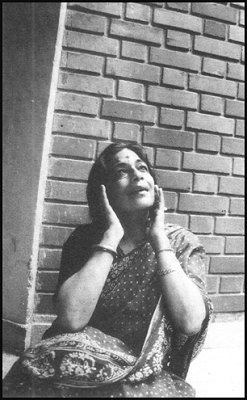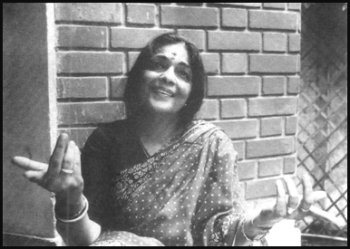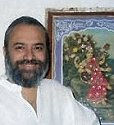
|   |

|   |
Uma Sharma - Ashish Mohan Khokar, Bangalore e-mail: mr.dancehistory@gmail.com Based on material from the Mohan Khokar Dance Collection November 6, 2011 "Nazar bana! Nazar bandh!" These words of my guru Shambhu Maharaj echo in my ears. He taught me how to use eyes for dance. He said, if you don't know this, you are not meant for dance," reminisces Uma Sharma.  Born in Delhi on November 20, 1942 to a family of litterateurs, which comprised of Acharya Pandit Vasudeva Sharma, Sanskrit vidwan for a father and Ratna Devi for mother, Uma grew up with her elder sister Rama. "I am born in Delhi for I will die in Delhi!" emphasises Uma who recalls when koels used to sing on mango trees and at night, jackals roamed the centre of the city. Today, she bemoans, real human jackals roam the city and the city stands destroyed with senseless construction, growth, pollution and people. "We have all collectively destroyed Delhi. Let's not speak on this, I get depressed," says Uma as we continue our recollections. "At school (St. Thomas), our teacher Vijaya Raghava Rao encouraged me to sing and I emulated film songs and danced on them. Today, he would laugh at it because we have both grown so much in our art. He is a world name in music composition and I have contributed my mite to dance. My father supported all my creative activities. From the age of 12, I have been involved in some or the other cultural activity and my sister Rama was a big support by participating in most." Shambhu Maharaj, the giant king of Kathak had been invited to Delhi by the Bharatiya Kala Kendra and his reputation as a flamboyant, boisterous, worshipper of both Bachchus and Venus preceded Uma's meeting with him. "His opening words were: Ama yaar, Kumkum ki tarah lagti ho! (Hey, you look just like Kumkum!) Kumkum was a well known actress of those days and I was on cloud nine. But his drunken state somehow did not gel with my strict Pandit upbringing and so I did not feel bold enough to learn from him." "I decided for a career in law! And enrolled for a law course. But deep inside, I was not certain if this was my calling. At home too, everyone started speaking of getting me married that really did me in. I pretended to be a gypsy girl who roamed from city to city and thus scared off all prospective suitors who came and soon most left wondering what sort of wife I would make." Narendra Sharma was then looking for young dancers for Begum Zaidi's Abhigyana Shakuntalam. He chanced to decide upon the sisters and so Rama undertook the role of Shakuntala and Uma, Priyamvada. "It seems Pandit Nehru praised our roles to Begum Zaidi and soon Sumitra Charatram won me over to her institution to do the role of Sita in their immortal production Ramlila. She treated me like a daughter, separately from her own Shobha." "I had some exposure to Bharatanatyam under Vijaya Raghava Rao. When the doyen of Kathakali, Guru Gopinath came to teach at the Kendra, I tried learning some Kathakali from him. We were brought up to believe that no style was exclusive and the more we learnt, the lesser we knew! The ocean was truly wide and our ability, not even a drop in it. Giants like Hafiz Ali Khan sahib, Vilayat Khan, Babu sahib (Amjad Ali Khan's elder brother Rahmat), Sunil Bose among others taught me so much. As children we had opportunity to see Ram Gopal, Tara Chaudhury, MK Saroja, Mrinalini - these were all legends." Naina Devi joined the Kendra as its Resident Director and soon things looked brighter for Uma as she was encouraged to learn Kathak. It was Keshav Kothari, a puppeteer from Rajasthan, a student of Kathak at the Kendra (who was later to work as an officer of the Sangeet Natak Akademi) who told Uma that she was meant for Kathak and took her to Guru Sundar Prasad to learn properly. "After learning from him, I felt somewhat confident to face Shambhu ji and by then I had realised his nature was second only to his greatness and I decided to become his shagird (disciple). He really gave me the insider's art of Kathak. Meri achchi talim shuru hui. (It was a good start to my learning.)"  "I worked very hard, forgetting the world around me and did riyaz for 6 to 8 hours until my feet ached or bled, I forgot all - even forgot how I would ever live alone were I to choose the path of being a professional dancer." "In order to acquire more, I sat with scholars like Suresh Awasthi, Mohan Khokar sahib, talked to them - asked questions, got answers and directions. Today I am saddened that no one has the time. Baatcheet se bahut gyaan milta hai. (One learns a lot just by talking). After all, who sent me to Brindavan? Awasthi ji. Kapila ji (Vatsyayan) was another significant source material." "Naina Devi supported my singing set to abhinaya. She kept saying how this art of vachika abhinaya was dying and that I at least, gifted with a good voice and ability to emote, keep it alive. She is no more. My gurus are no more and I am left alone. Sabo ka khazana rakh ke khamosh baithi hoon (I have all their legacies in me)." "My rivals, who grew with me and learnt from the same gurus, are trying to say, 'What do I know of Kathak, what right I have to the art as I am an outsider to their gharana.' It is not for these people to decide if I belong to a gharana or not. My gurus decided it for once and all by gifting me their art!" "But I carry on with my mission. Brindavan and its raas has become one." Uma Sharma's singular devotion to Braj Raas has helped platform it in city environs. She genuinely immersed herself in the persona of Radha because as Pandit Vidyaniwas Mishra said, "Only if you involve and immerse yourself completely in the role of Radha, you will be able to show her true personality." Uma has set her dance to divergent poetry, including contemporary ones like Faiz, Niraj, Vajpayee. "Doing productions like Stree, Madhushala, Indersabha, has brought me new insights into the art form. My institution, built brick by brick (the Bharatiya Sangeet Sadan where Sivananda Yogashrama is housed too) has helped turn out able students and on the whole more than the various awards like the Parishad Samman in 1985 and the Akademi Award in 1987, the progress of my shishyas bring the joy." Unlike others, who first platform and praise their own students, Uma Sharma praises Shovana Narayan, Prerna Shrimali and students of Munnalal Shukla and Rajendra Gangani. She also makes a special mention of Ram Mohan, Shambhu Maharaj's son and emphasises that Birju Maharaj ought to focus on giving some of his art to his son Deepak, who is gifted. "My own students I cannot speak for lest they become big-headed. However, Radhika among these is worthy. There is so much for all of us to learn, to understand. There is still lot to be done and miles to go before I sleep...." "Especially when I see all this experimentation business. Some innovation is fine but today the trend is to senselessly experiment. The old form of Kathak is in short supply. Give me poetry, give me soulful music, what more does a dancer need?" Uma Sharma dances on.  Ashish Mohan Khokar learnt Kathak, Bharatanatyam, western ballet and Orissi before taking to arts administration. He served the govt., in many cultural capacities, including the Delhi State Academy for Arts (1984-85); chief coordinator Festivals of India in Sweden (1986-87); Festival of India in France, Germany and China (1985-90). He was Director of INTACH, under PM Rajiv Gandhi's Chairmanship. He served the Times of India as Dance Critic in Delhi from 1990-2000 and Bangalore 2000-3. Since then, he edits and publishes India's only yearbook on dance - attendance - and is Curator of the Mohan Khokar Dance Collection. He has served dance for over 25 years as a reputed critic-historian. He has written over 35 books on Indian arts and culture; is on many boards and committees serving dance (DD, INTACH, IIC, BSM, ICCR, UNESCO-DC). He is currently also the chief consultant to India's first dance museum shaping up in Kerala. He Chairs the Dance History Society of India and holds special dance DISCourses. attendance-india.com Post your comments Pl provide your name and email id along with your comment. All appropriate comments posted with name and email id in the blog will also be featured in the site. |